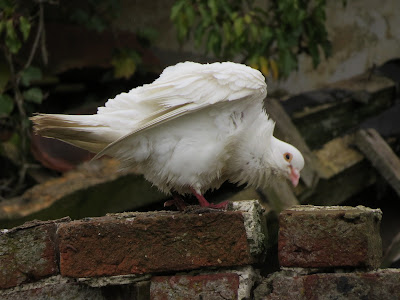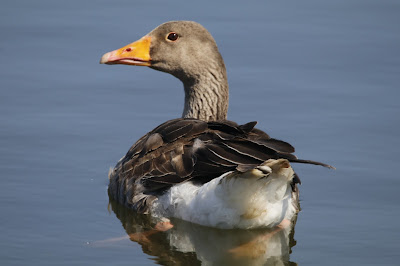I don't really know the area that makes up the Suffolk Broads, the Suffolk Wildlife Trust reserves that lie on the outskirts of Lowestoft. A fairly ill fated walk from Beccles to Oulton Broad South last June was the only time I've visited here. So with some time off work, looking to go somewhere that wasn't Minsmere and with an AMERICAN BITTERN being reported from the area it was decided we should have a little look.
Langham Bridge, Blaxhall
A COMMON CRANE was reported on the Suffolk Bins website, as being present at Langham Bridge, Snape, the day before. As this was so close to where my brother was staying, we decided to have a look for it on the way to Carlton Marshes. The bridge was located on the outskirts of Blaxhall, along a country lane, single lane with grass growing in the middle. When we got there there were around six or seven people who had turned up with the same idea as us, creating a mini twitch. The area was a piece of rushy wet grassland, bestrode by lots of powerlines. It was typical CRANE feeding countryside, but we didn't see the bird, although it was reported as present this day.
CRANE country
Carlton Marshes
We headed off from Blaxhall and followed the A12 up to Lowestoft. The Suffolk Wildlife Trust reserve is located right on the edge of Lowestoft, not far from Oulton Broad South train Station. It is currently going through a public appeal to extend the reserve by maybe three times the size. It seems that they have, finally, managed to raise
enough money to buy all the surrounding land, creating a new super size reserve. In all it was a lot of money, £4 million all told, of which the Trust had to raise a million, but they managed it, to turn poor farmland into a super wetland.
The actual reserve as it is at the moment, is quite small, an area of fen, and some wet grassland. It exists in parcels surrounded by land they hope to acquire.
We arrived at the car park around 11, went to the visitor's centre looking for a coffee only to discover it was only used as an education centre of which there was a group of school kids, but they didn't bother us. A coffee machine could have been available at least but they do plan to build a new visitor's centre with the new reserve so in a couple of years maybe one will be available and I can get my caffeine fix.
A map showed the location of the AMERICAN BITTERN, it was reported from an area that wasn't part of the reserve, yet, but it is in the area they want to buy. Got it?
It was a good walk to get there, travelling through typical broadland country, comprised of rough grassland with areas of reed, extremely flat with no high ground. There were loads of SEDGE WARBLERS establishing territories, with a newly arrived REED WARBLER providing a good comparison between the two similar songsters. There were quite a few REED BUNTINGS as well, not surprisingly considering the habitat of the area.
Lots of CHINESE WATER DEER were seen today, often grazing out in the open, sometimes running and disappearing into areas of reeds. These animals have now become an established species in our wetlands, having been introduced from China, so much so that it would be strange not to see them.
Share Marshes - AMERICAN BITTERN country
Without seeing anyone around the reserve, it was a bit of a surprise to stumble on a group of around twenty people all set up with bird watching equipment focused on the countryside. Of course this was a twitch and the people were all looking for the AMERICAN BITTERN. We found out it was seen around three minutes ago by an area of a sheet metal thing, having been seen in flight. BITTERNS at the best of times are highly secretive, with cryptic plumage and a love of hiding away in thick cover, the best chances of seeing them are mostly in flight.
As the minutes went by I was thinking it was one of those twitches - hanging around for four hours then briefly seeing a bird that someone claims is the species you were after. However we only had to wait around twenty minutes, as the bird flew up from the area it had been skulking and flew, for maybe a minute across the marshes. You could see the stand-out colours of its neck and wing, which were different from EURASIAN BITTERNS. Suddenly from what was a fairly sombre group everyone broke out into cheering as the sighting really lifted the mood. Great, we saw it, I didn't expect to, my first ever sighting of this species and only the fourth ever rported in the country, so a good record, even for those who don't like twitching, like myself.

We moved on as the twitchers dispersed, and followed a circular route back to the car park. A scrape in an area of grassland held a few AVOCETS, as well as the usual marshland birds. Some SNIPE were put into the air by a passing MARSH HARRIER. SWALLOWS and HOUSE MARTINS were flying over the meadows in pursuit of airborne insects.
A CUCKOO was heard calling over the marshes, but was too far away to see. A WATER RAIL was heard squealing from an area of reedbed. We came back to the car park, quicker than we expected, but apart from the AMERICAN BITTERN, there wasn't too much to see.
There was a small colony of pure white DOVES in an abandoned farm building.
With Carlton Marshes completed it was over to Oulton Marshes, the Trust's second reserve in the area, a bit larger than Carlton Marshes, and situated north of the river. It was more low key than Carlton Marshes, with a small car park by the church, and only the odd sign, you wouldn't really know there was a reserve there.
Typical Broads country
As we entered the reserve the area was overgrown fen, and the first birds we heard were WILLOW WARBLERS, birds that are becoming hard to find and my first for the year. The path crossed the train line and from there we heard a GRASSHOPPER WARBLER reeling, a monotonous song which people say sounds like the reeling of a fishing rod. The path cut in and we heard a CUCKOO calling. We looked around for it, and with great luck managed to find it perched fairly openly on a poplar. As we moved on another CUCKOO flew over, not the same one as the one before was still calling. The path joined the river wall and as it did so the reserve opened out into wet grassland, a landscape which stretched far to the horizon. On a scrape were pairs each of AVOCET, REDSHANK, SHOVELLER and TEAL. The path followed the shape of a square and we soon returned to the car park. On the way we passed a small holding which held a curious EMU, a surreal sight to find in Suffolk. Two MUNTJACS as we finished rounded off a nice walk.
EMU
The Suffolk Broads until now had always been overlooked compared to the much larger areas in Norfolk. Until now the Suffolk Broad reserves had always been small scale, with little to offer to birdwatchers, when compared to places like Hickling. But it was nice to finally see the place, something I have been planning to do for a long time. Of course seeing the AMERICAN BITTERN was good, it was just apart from that there wasn't much else. Hopefully when the Trust completes its objective of acquiring all the surrounding land into a super reserve it will turn into a great destination.

















































